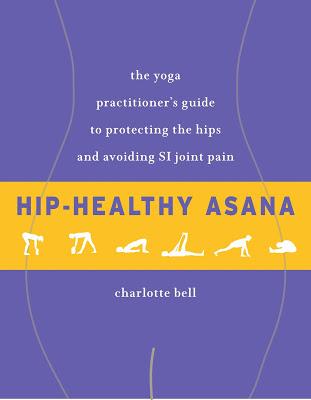
I'm pleased to announce that today is the release date for Charlotte Bell's latest book Hip-Heathy Asana: The Yoga Practitioner's Guide to Protecting the Hips and Avoiding SI Pain! You can order this important book from Amazon, Shambhala Publications, Indie Bound, or your local bookstore. Would you like to know more about the book? Yes, I thought you would. That's why I did a rather in-depth interview with Charlotte that I'm featuring today so you can learn why she wrote a whole book about how to keep your hips healthy with yoga and what her basic approach is to hip health.
Nina: Can you introduce yourself to our readers? What is your yoga background? And what are your previous publications?
Charlotte: I began practicing asana in 1982. My first teacher was a student of Indra Devi. Six months after I started practicing, I moved to Salt Lake City and connected with teachers in the Iyengar tradition. I studied in that tradition for decades. My most influential teachers have been Donna Farhi, Judith Hanson Lasater, and Elise Miller. I began practicing Insight Meditation in 1986 with Pujari and Abhilasha Keays, also certified Iyengar teachers, and regularly attend retreats there and at Spirit Rock Meditation Center. I’ve taught yoga, mostly in Salt Lake City and the surrounding area, but also in San Diego, Vancouver, BC, and Volcano, Hawaii.
I’ve been writing a yoga column for CATALYST Magazine for about 10 years, and also write for Yoga U Online and the Hugger Mugger Yoga Products blog. Previous to writing my book Hip-Healthy Asana, I wrote two books that were published by Rodmell Press and are now a part of Shambhala Publications’ list: Mindful Yoga, Mindful Life: A Guide for Everyday Practice and Yoga for Meditators: Poses to Support Your Sitting Practice.
Nina: After writing your previous books, what made you decide to focus an entire book on yoga for healthy hips?
Charlotte: I became very interested in the subject of hip-healthy practice after being blindsided by a hip x-ray indicating that there was significant degeneration in both my hip joints. I had thought that because I was flexible and had kept myself in good shape that my hips were immune. Nothing I did in yoga practice felt uncomfortable, even the most extreme poses. What I didn’t know then was that cartilage has no enervation. This means that you don’t feel degeneration until your cartilage is gone and your joint is bone on bone. All of my most influential yoga teachers, at some point, suggested that I focus on stabilizing my joints instead of pushing my natural flexibility. But I was under the mistaken impression that yoga was about becoming more and more flexible. Because of this, it fed my ego to be the most flexible person in the room so I just kept pushing my flexibility. These days, I think that there’s even more pressure to perform the “advanced” poses that push your joints to their limits. People who post photos of themselves doing some of the really crazy poses on Instagram get lots of encouragement and kudos. As yoga has become more popular, the extreme poses, which, in reality, most people’s structures will never be able to perform, have become the gold standard. While I know that my particular genetic inheritance, specifically hip dysplasia, is the reason for my bilateral hip replacements, I also wonder if the crazy poses I used to practice may have sped the process up. So my idea in writing this book is to give yoga practitioners an alternative viewpoint that might help them prevent problems further down the road.Nina: I’m very glad you’re taking on this topic because I know that hip problems, including hip joint wear and tear as well as SI joint problems, are a kind of “dirty secret” in the yoga community. In a nutshell, what is your basic advice for yoga practitioners to help avoid hip injuries and/or problems.
Charlotte: There are many reasons that people’s hip and SI joints degenerate and destabilize when they practice yoga. Some people are more prone to problems than others simply because of differences in structure. So it’s a bit of a challenge to come up with some sort of blanket, anatomy-based advice. If there were any advice I could give about the mechanics of practice, I’d encourage people to question alignment cues, to take time to feel the effects of them on your own body. There’s really no single instruction that is going to fit everyone. Some of the alignment “rules” that have persisted for decades don’t make anatomical sense and can even cause hip and SI joint problems. Instructions such as squaring your hips in standing poses have been taken as gospel for decades. My experience with this particular instruction is that it really doesn’t make sense for most people’s bodies. The intention you bring to practice determines the eventual results of your practice. That’s why a good portion of Hip-Healthy Asana addresses intentions for practice. Here are a few suggestions invite exploration into how you approach your practice:
- Do your own practice. Comparing your practice to someone else’s is not productive. We all come into the world with very different structures. Some people’s hip sockets are shallow; other people’s are deep. The location of hip sockets on the pelvis and the angle of various hip sockets can be very different. The size, curvature, and angle of the femur shaft can be really different. All this means that no two people’s yoga poses are going to look the same. Comparing yourself to someone else is truly futile, and trying to emulate someone else’s practice can cause injury.
- Develop an inner reference system. Mindfulness goes hand in hand with healthy practice. As I said earlier, we won’t feel the effects of pushing too far into our hip joints if our cartilage is still intact. So shifting your intention from pushing into your edge to gently approaching your edge—and even staying a bit inside your edge—will help you keep your joints within their healthy range of motion.
- Stability is as important as flexibility. We all know that being too stiff is a form of imbalance. But most people who practice yoga don’t recognize that being too flexible is also a state of imbalance. Practice to find a balance between mobility and stability. Practice stabilizing poses, such as balancing poses and standing poses, to build strength.
Nina: And what about people who already have these types of problems?
Charlotte: It’s important to understand that everyone’s practice has to change according to the reality of their present situation. I had SI joint instability for years that often turned into painful sciatica. Because of this, I had to alter my practice, which meant giving up some poses I really liked that were exacerbating the problem. Pigeon Preparation pose was one of them. Not only do we come into the world with our own unique structures, but our bodies also change over time. We need to be flexible enough (pun intended!) that we can let our practice evolve with us.
Nina: I once wrote a post called Not All Yoga Poses Are Created Equal, in which I said that some poses should probably not be practiced every day while others were safer for regular practice. What are your thoughts about that? And, if you agree, which poses do you think should be practiced only occasionally and why.
Charlotte: That’s a great post! I like to use a food metaphor for this idea: There are certain poses that are like vegetables. They’re the basics that provide sustenance and should be the foundation of your practice. In general, these are the simpler ones: standing poses, balance poses, restorative poses, and gentle twists, backbends, and forward bends. Then there are the “fancier” poses, which are more like dessert. They can feel good to do once in a while, but they don’t provide sustenance. If you do these so-called “advanced” poses every day, you’re more likely to suffer imbalances. The extreme “fancy” poses, such as putting your ankle behind your head, have no evolutionary purpose in terms of helping us maintain health or grace in performing our everyday activities. In fact, destabilizing or degrading your joints from practicing too forcefully can make everyday movements more painful and difficult. It took decades, but I’ve finally given up the desire to do these poses. I no longer feel there’s something I need to prove. Maybe that comes naturally with age or maybe it has to do with having gone through two hip replacements. Even though my titanium hips are every bit as flexible as my original ones were, I just have no desire to practice the fancy poses anymore. They don’t serve my ability to move through my life.So, in a nutshell, I’d say that the poses that can help you do the things your physical body needs to do to accomplish your daily tasks are the staples. Poses that help you sit, walk, run, squat in your garden, climb stairs, and get down onto the floor and get back up are the poses that should be a part of your daily practice. Also, it’s important to vary your practice. Practicing the same poses every day can cause repetitive strain injuries over time. Tune into what your body needs on a given day.
Nina: Do you have anything else you’d like to say to our readers about hip health?
Charlotte: Yoga practice can’t grow your cartilage back if your hip joints degenerate to the point where they need to be replaced. But it can help you move through the process of replacing your hips with greater ease. A committed foundation of asana practice can help you recover much more quickly. If you do find yourself facing a hip replacement, be thankful that the technology is improving all the time. In the year and eight months between my two replacements, the hardware changed slightly and the post-surgery and physical therapy protocols changed for the better. My hip replacements truly gave me my life back. I wouldn’t be walking today, let alone enjoying yoga practice, if it hadn’t been for my hip surgeries. Every time I find myself wandering the gorgeous landscapes in my adopted home of Utah, I feel grateful for the technology that helped me regain my ability to hike.
Nina: What are you up to these days? And are you planning to tackle any new topics? Charlotte: I’m doing a lot of writing and editing, for Hugger Mugger Yoga Products and Yoga U Online. I really enjoy getting to read the articles on Yoga U—including yours—because I always learn something new. I’ve enrolled in a two-year mindfulness teacher training program that starts next January, so that will keep me busy, along with my own classes and workshops. I continue to flesh out my workshops on healthy hips. There’s so much more to learn! I’ve got a few ideas in mind for a possible new book topic, but I need to develop them a bit more before I’ll feel ready to write a proposal. I’m pretty sure my next writing project will lean more toward philosophy and meditation, but I’m not sure exactly what it will be yet. 

